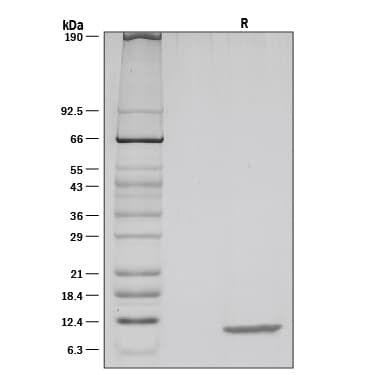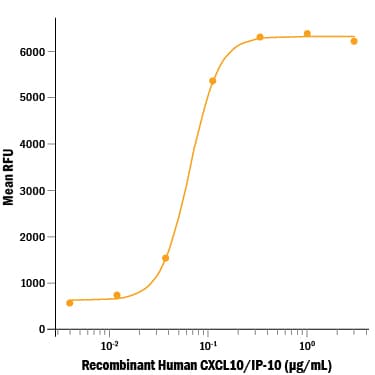 全部商品分类
全部商品分类



 下载产品说明书
下载产品说明书 下载SDS
下载SDS 用小程序,查商品更便捷
用小程序,查商品更便捷


 收藏
收藏
 对比
对比 咨询
咨询Scientific Data
 View Larger
View LargerRecombinant Human CXCL10/IP-10/CRG-2 (Catalog # 266-IP) chemoattracts the BaF3 mouse pro-B cell line transfected with human CXCR3. The ED50 for this effect is 0.03-0.18 μg/mL.
 View Larger
View Larger1 µg/lane of Recombinant Human CXCL10/IP-10/CRG-2 was resolved with SDS-PAGE under reducing (R) conditions and visualized by silver staining, showing a single band at 9 kDa.
Carrier Free
CF stands for Carrier Free (CF). We typically add Bovine Serum Albumin (BSA) as a carrier protein to our recombinant proteins. Adding a carrier protein enhances protein stability, increases shelf-life, and allows the recombinant protein to be stored at a more dilute concentration. The carrier free version does not contain BSA.
In general, we advise purchasing the recombinant protein with BSA for use in cell or tissue culture, or as an ELISA standard. In contrast, the carrier free protein is recommended for applications, in which the presence of BSA could interfere.
266-IP
| Formulation | Lyophilized from a 0.2 μm filtered solution in PBS with BSA as a carrier protein. |
| Reconstitution | Reconstitute at 100 μg/mL in sterile PBS containing at least 0.1% human or bovine serum albumin. |
| Shipping | The product is shipped at ambient temperature. Upon receipt, store it immediately at the temperature recommended below. |
| Stability & Storage: | Use a manual defrost freezer and avoid repeated freeze-thaw cycles.
|
266-IP/CF
| Formulation | Lyophilized from a 0.2 μm filtered solution in PBS. |
| Reconstitution | Reconstitute at 100 μg/mL in sterile PBS. |
| Shipping | The product is shipped at ambient temperature. Upon receipt, store it immediately at the temperature recommended below. |
| Stability & Storage: | Use a manual defrost freezer and avoid repeated freeze-thaw cycles.
|
Recombinant Human CXCL10/IP-10 Protein Summary
Product Specifications
Val22-Pro98, with an N-terminal Met
Analysis
Background: CXCL10/IP-10/CRG-2
CXCL10 was originally identified as an IFN-gamma -inducible gene in monocytes, fibroblasts and endothelial cells. It has since been shown that CXCL10 mRNA is also induced by LPS, IL-1 beta, TNF‑ alpha, IL-12 and viruses. Additional cell types that have been shown to express CXCL10 include activated T‑lymphocytes, splenocytes, keratinocytes, osteoblasts, astrocytes, and smooth muscle cells. CXCL10 is also expressed in psoriatic and lepromatous lesions of skin. The mouse homologue of human CXCL10, Crg-2, has been cloned and shown to share approximately 67% amino acid sequence identity with human CXCL10. Human CXCL10 cDNA encodes a 98 amino acid (aa) residue precursor protein with a 21 aa residue signal peptide that is cleaved to form the 77 aa residue secreted protein. The amino acid sequence of CXCL10 identified the protein as a member of the chemokine alpha subfamily that lacks the ELR domain. CXCL10 has been shown to be a chemoattractant for activated T‑lymphocytes. CXCL10 has been reported to be a potent inhibitor of angiogenesis and to display a potent thymus-dependent antitumor effect. A chemokine receptor specific for CXCL10 and Mig has been cloned and shown to be highly expressed in IL-2-activated T‑lymphocytes.


参考图片
1 µg/lane of Recombinant Human CXCL10/IP-10/CRG-2 was resolved with SDS-PAGE under reducing (R) conditions and visualized by silver staining, showing a single band at 9 kDa.
Recombinant Human CXCL10/IP-10/CRG-2 (Catalog # 266-IP) chemoattracts the BaF3 mouse pro-B cell line transfected with human CXCR3. The ED50 for this effect is typically 0.03-0.18 μg/mL.



